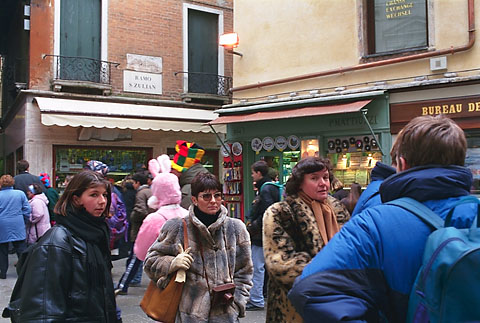  A bustling small square in Venice
SocietyCities are the great havens for knowledge, culture, and social life. Vibrant cultures are found in cities because it takes a large population to support museums, concert halls, sports teams, and night-life districts.Cities also offer rich social opportunities. People in rural areas enjoy only limited social opportunities because of the small local population. City dwellers can choose their friends and mates from among a large number of people of similar interests and inclinations. We are not likely to abandon the city as a cultural institution, but we need to make sure that our transport arrangements do not damage the city's other functions.
The Built EnvironmentIt is only in America that cities are no longer regarded as the richest of man's built environments. Urban decay is as old as cities, but urban blight is something else again: it occurs when healthy city economies are undermined by the flight of the middle class to the suburbs. This process has gutted many American cities in the period since World War II. The suburbanites still depend on the city for their livelihood but no longer contribute much to its sustenance. The creation of metropolitan governmental authorities encompassing a city and its suburbs would do much to balance the economic inequities which have arisen and help to assure the financial health of cities.Most great buildings and vibrant outdoor spaces are in cities. One has only to think of the great European capitals to find examples. New York, Boston, and San Francisco all have lively districts. St. Marks Square in Venice is perhaps the greatest example. Europe largely succeeded in preserving its cities during the past 50 years, while the hearts of many US cities became wastelands. Three decades ago in a speech at Johns Hopkins University, Daniel P. Moynihan argued that one of the contributors to social malaise in the United States was the generally bad quality of public architecture since WW II. I believe now, although I did not at the time, that he is not only correct but too conservative in his views. In fact, the poor quality of virtually all the built environment in the United States causes a wide variety of social and psychological problems. A healthier society awaits the decision to construct buildings which respect the environments in which they are sited and which better serve basic human needs.
Transport and its Effects on CitiesThe size of cities is limited by the availability of food that can be transported to the city and still sold cheaply. The explosive growth of London in the 19th century followed the development of canals and railroads. Today, the growth of cities such as Los Angeles, Bangkok, and Mexico City is limited by transport systems that have ceased to function at a tolerable cost (including the cost of travel time and indirect costs such as pollution).Since the economic power of the city depends in part on bringing large numbers of people within close proximity to one another, it is important to encompass as many people as possible. This can be done either by increasing the population density or by increasing the average speed of the transportation system. The effectiveness of an urban transport system is therefore measured in time, not in distance. Public transport does not usually measure up very well - a competent bicyclist is usually faster door-to-door than the bus or even the subway. In many large cities, the car no longer delivers high door-to-door speeds, either. Even freight deliveries have become expensive due to the congestion of city streets and the resulting delays. Large cities based primarily on road transport are now choking on congestion, and these cities will face mounting difficulties unless they adopt a more effective transport system.
|
Continue on to Groundwork
Back to More
Return Home
About the book: Carfree Cities
E-mail
carfree.com
Copyright ©1996-2002 J.Crawford